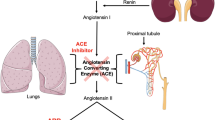Summary
The central role of the renin-angiotensin-aldosterone system in the regulation of fluid balance and haemodynamics was not fully appreciated until the discovery and clinical application of inhibitors of the angiotensin-converting enzyme (ACE). Captopril, the first orally active compound has proved to be highly effective in mild, intermediate and severe hypertension and in congestive heart failure. This is also true for enalapril, the first of the second generation (non-sulfhydryl) of ACE inhibitors. Both compounds combine a high degree of clinical efficacy with a low rate of side effects, and both are eliminated via renal excretion. Thus, reduced doses are required in renal failure. Captopril has a shorter half-life and requires more frequent dosing than enalapril. Whether long-acting ACE inhibitors carry distinct advantages or disadvantages compared with short-acting ones is not clear, but both possibilities must be considered.
Among many new ACE inhibitors being developed, compounds eliminated via hepatic routes, such as fosfenopril and zofenopril, may prove advantageous in renal failure. Very long-acting ones, such as lisinopril, a potent ACE inhibitor already shown to be clinically effective, may add value to this group of therapeutic agents.
Drug compliance may be easily tested by measuring ACE activity in serum from patients treated with stable ACE inhibitors, such as enalapril and lisinopril, which is an obvious advantage compared with other antihypertensive compounds. The presence of ACE in sites not associated with regulation of fluid balance or blood pressure, such as macrophages and reproductive organs, and the possibility that new functions of ACE may be discovered, call for vigilance regarding possible long term side effects of ACE inhibitors.
Similar content being viewed by others
References
Biollaz J, Schelling JL, Jacot des Combes B, Brunner DB, Desponds G, et al. Enalapril maleate and a lysine analogue (MK 521) in normal volunteers; relationship between plasma drug levels and the renin angiotensin system. British Journal of Clinical Pharmacology 14: 363–368, 1982
Ferreira SH. Bradykinin potentiating factor (BPF) present in the venom of Bothrops jararca. British Journal of Pharmacology 24: 163–169, 1965
Frohlich ED, Cooper RA, Lewis EJ. Review of the overall experience of captopril in hypertension. Archives of Internal Medicine 144: 1441–1444, 1984
Fyhrquist F, Hortling L, Forslund T, Laasonen L. Reduction of plasma vasopressin and renin substrate in congestive heart failure during captopril treatment. In Cohn JN (Ed.) ACE inhibition in congestive heart failure: from principle to practise, pp. 51–62, Biomedical Information Corporation, New York, 1982
Fyhrquist F, Grönhagen-Riska C, Hortling L, Forslund T, Tikkanen I. Regulation of angiotensin converting enzyme. Journal of Hypertension 1(Suppl. 1): 25–30, 1983
Gomez HJ, Cirillo VJ, Irvin JD. Enalapril: a review of human pharmacology. Drugs 30(Suppl. 1): 13–24, 1985
Maslowski AH, Nicholls MG, Ikram H, Espiner EA. Haemodynamic hormonal and electrolyte responses to captopril in resistant heart failure. Lancet 1: 71–74, 1981
Öhman KP, Kågedal B, Larsson R, Karlber BE. Pharmacokinetics of captopril and its effects on blood pressure during acute and chronic administration and in relation to food intake. Journal of Cardiovascular Pharmacology 7(Suppl. 1): 20–24, 1985
Romankiewicz JA, Brogden RN, Heel RC, Speight TM, Avery GS. Captopril: an update review of its pharmacological properties and therapeutic efficacy in congestive heart failure. Drugs 25: 6–40, 1983
Author information
Authors and Affiliations
Rights and permissions
About this article
Cite this article
Fyhrquist, F. Clinical Pharmacology of the ACE Inhibitors. Drugs 32 (Suppl 5), 33–39 (1986). https://doi.org/10.2165/00003495-198600325-00005
Published:
Issue Date:
DOI: https://doi.org/10.2165/00003495-198600325-00005




